|
|
|
To document events of “Operation Thursday” without writing of General Orde Wingate would be an impossible dream. Through the years much has been written of Lawrence of Arabia but to write of Wingate one must pen of the Lawrence of Judea, the Lawrence of Ethiopia and finally the Lawrence of Burma. A natural born guerrilla leader – fearless and inexhaustible.
By the age of seventeen Wingate had formed a high regard for the League of Nations in principal yet felt its success would rest on the formation of a police force to advance its dictum. Thus he entered the British Armed Forces.
After a tour of duty in Egypt and in Sudan he returned to England where his revolutionary thinking and deeds became a thorn in the side of the army and he was sent to Palestine assigned to Headquarters as an Intelligence Officer – an assignment considered of the lowest prestige.
With the two Semitic peoples, Jews and Arabs claiming the country the British
Army favored the Arabs. Wingate declared his support for the Jewish
position and wanted to join in the battle to free Palestine in direct disregard
for the British hands off policy. His request to allow the Jewish people
to raise their own army went all the way to the Prime Minister’s desk.
Although the Arabs burned houses, ruined crops, mocked British control
and killed cattle and children Britain retained its hands off policy until
the Arabs, supported by Axis funds, began to puncture oil lines.
With the flow of oil to British ships threatened, which, in turn, raised
concern to the navy, keeping control over the Suez Captain
Wingate was given the go ahead with
his private army. He formed  copy (5).jpg)
special
squads fighting in
commando style
accomplishing
in six months, with 600 men, what
the British
Army could not achieve with
20,000 troops. Although successful his tactics rendered him
unpopular with British High Command and he was ordered to disband the Special
Forces and to return to England. He had tested his theories of guerrilla
warfare, based on the bible, and had been successful. He had tried hard
to live up to the exploits of Gideon with his “Special Night Forces”. This
would be the foundation for all of his future offensive dreams, goals and
victories. He had inspired the imagination of the public and many politicians.
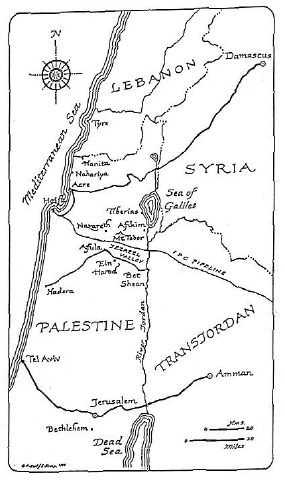
“THE NIGHT RAIDERS”
WINGATE IN PALESTINE
(SEE CREDIT ONE)
He would depart Israel a hero blessed by its government and citizens. Born into the Plymouth Brethren Protestant faith and raised in the fear of God he would, in later life, accept Zionism as his faith with a burning desire in his heart to return to the land of his dreams – dreams that would never come true due to his death in an air crash in India. To this day parks, avenues and the likes are named in his honor and mention the name Wingate to any Israelite and they will expound with praise.
By 1939 many nations faced appeasement and defeat. Mussolini moved quickly through Abyssinia and Haile Selassie’s last appeal to the United Nations fell on deft ears. This, of course gave fire to Wingate’s theory that the United Nations needed a police force. He voiced loudly that, given the opportunity, he would bring back the Emperor of Abyssinia. Words that, when they reached British High Command, caused him to be promoted to Major and sent to Abyssinia where he would once again meet with success using a pattern very similar to that used in Palestine. His “Gideon Force” would march into Ethiopia on 1 January of 1941 divided into two columns and thence into smaller units for quick thrusts and raids at night. The major amassed 1,500 camels as his transportation corps of which only a few survived the tough going. On 5 May, with the joy of success, he rode a white horse into Addis Ababa leading Haile Selassie and his troops pass joyous crowds.
Although triumphant he was down in heart after learning what was going on behinds the scenes. To Wingate the restoration of the Emperor, as was the restoration of Palestine, of historic justice while in London it was a matter of political strategy and they were unimpressed by the Abyssinia campaign. Miserably unhappy and suffering from a near breakdown, Wingate returned to Cairo with a severe case of Malaria. Rather than seeking out a military medic he visited a civilian doctor who supplied him with a large supply of Atabrin without advising of the side effects. While in the hospital he slashed his throat. The fast thinking and deeds of an officer in the next room who heard the commotion saved his life. For the rest of his life he would he would have to turn his entire torso to move his head sideways as he had lost much movement in his neck.
While conventional military leaders saw Wingate as a young upstart, a madman, General Archibald Wavell saw the great significance of his guerrilla tactics - tactics he felt could be used in other troubled spots in the world.
Wavell, Commander of Middle East and North Africa forces has lost face
with Churchill in that he was unable to come up with an offensive against
the famed, and highly respected German Field Marshall Erwin Rommel. He
was transferred from Africa to Burma and given the title of Commander in
Chief in India. Burma was another situation very similar to Palestine and
Abyssinia as far as military and political standpoints were concerned.
Thus he requested, and received
permission, to have
Wingate promoted to the rank of brigadier, and go with him. The brigadier
would once again be
given an opportunity to amass a commando force.

“THE GIDEON FORCE”
WINGATE IN ETHIOPIA
(SEE CREDIT ONE)
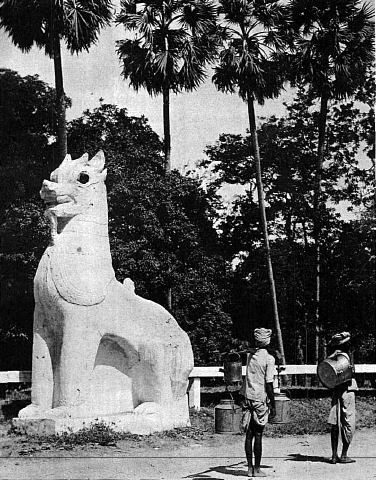
THE “CHINTHE”
GUARDIAN OF THE TEMPLES
Operation Longcloth began on 6 February 1943 as Brigadier Wingate entered Burma on foot from the Northeast corner of India with what he called his “ Long Range Penetration Group” named “Chindits” after the “Chinthe” a mythological half lion, half griffin statue that guarded Burmese pagodas warding off evil spirits. As in Palestine and Abyssinia two columns marched into Burma - one as a decoy and the second to head for the main railway line from Mandalay to Myitkyina. As in Abyssinia he relied on an animal force - this time Elephants. To avoid contact with the Japanese he refrained from using any of the established roads or paths. He would carve his way through the dense, hot, disease infected jungle, using elephants to lead the way crushing all obstacles before them. It was to be that the troops would exist off the lay of the land and supplies dropped from the air by the Royal Air Force “Dakotas.
He would make his way to and across the Irrawaddy River with slashing blows blowing up railroad sections, bridges and ripping into enemy communication lines. With the Monsoon season upon them and the Japanese, now aware of their tactics, and driving towards his force he found it necessary to withdraw. Some of his “Chindits” made it to China while others trudged back to India surviving by eating items such as boiled mules and pythons. The hot dense, disease infected jungle and Japanese action took their toll and many of the sick and wounded had to be left behind to either die of be taken by the enemy. This would weight heavy on Wingate’s mind and be a very important factor in the planning of the second invasion – “Operation Thursday.”
Although military leaders felt the operation to be of little value to military planning, Churchill made much of the Brigadiers’s success and would remain by his side until his untimely death. He had proven that a force could advance into enemy territory, being totally supported by air and the lay of the land and defeat the enemy.
He was called back to London and immediately upon his arrival was summed
to the War Office without even having an opportunity to see his wife.
Here he was advised that he would be traveling to Quebec Canada with Winston
Church and his staff for a Supreme Command meeting with President Roosevelt
and his aides. Churchill, upon learning he did not have a chance to visit
with Mrs. Wingate, took immediate action to have her travel with the entourage.
It was at Quebec that
the Southeast Asia Command was created and Lord Louis Mountbatten placed
in command. The forgotten war in Burma would now be of prime priority toward
the defeat of the “Land of the Rising Sun.” “The Fighting Scot” was
promoted to Major General and was to expand his previous raid into
a full-fledged campaign to be named “Operation Thursday.”
The Quebec Conference will be included as yet another tale on this website.
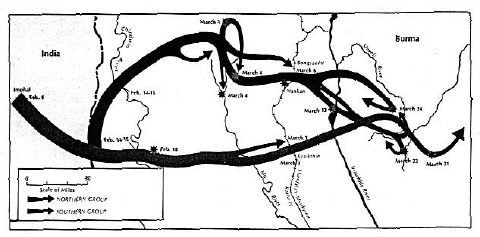
“OPERATION LONGCLOTH”
“CHINDITS” - FIRST
INCURSION
WINGATE IN BURMA
(SEE CREDITS TWO)
General Wingate made it clear he would not proceed until arrangements could be made for his sick and wounded to be taken out by air which he felt could be accomplished using small aircraft. Roosevelt assured him this could be done promising that 300 or more light planes and crews would be assigned to the campaign. Thus General Henry “Hap” Arnold, Commander of the United States Army Air Force, was brought into the picture with orders to give full support to the program. Going far beyond what Wingate expected Roosevelt ordered a special aerial task force to be created operating totally outside of the system, which excited General Arnold. The unit would be called “Force Nine” - later to be renamed four times with the final identity being “First Air Commandos.”
In addition Roosevelt promised an American Ground Force of 2,000 men to serve under Wingate. The unit to be given the title of 5307TH Composite Unit (Provisional.) General Joseph “Vinegar Joe” Stilwell, Commander of the Theater at the time, was enraged that the unit was not placed under his command and thus registered his discontent to his West Point classmate General George Marshall. As a result the force was transferred to Stilwell’s authority. In addition, “Vinegar Joe” was upset with the chosen Commander of the unit and insisted it be given to his dear friend General Frank Merrill. This also came to be. Being a friend of the Commander of the United States Armed Forces, Stilwell had visualized his being placed in command of a major theater – mainly the European Theater of Operations. When given the command of the CBI he then labored under the impression that at least three American divisions would be assigned to serve under him. With but 2,000 men being sent to his theater he was not pleased to say the least. To many in the CBI the general became known as the “Cankerous Old General” - a General very difficult to work with.
To advance Project Nine a search was made to find a commander for the air unit and deputy Air Force Chief of Staff General Craig recommended two promising Colonels be given consideration - Lieutenant Colonel Phillip Cochran and Lieutenant Colonel John Alison. After General Arnold interviewed the two officers several times he came to the conclusion that in as much as they thought so much alike, and friends of long standing, they should both be sent overseas. A first in US military history and one of several firsts to be established in the North Burma campaign.. With Cochran having served in the Air Force a short time longer Alison considered him as the leader of the force.
Once selected the two men were given complete authority to commandeer any
unit, material or man power they felt were needed and advised by General
Arnold “to hell with the paper work - just get the job done.” This would
be another first and the two used it wisely and successfully. Amassed
were 100 Waco CG-4A gliders, 100 light planes mostly L-5s, 20 Mitchell
B-25 Medium Bombers, 20 Douglas C-47 transports, 30 North American P-51
fighters and 6 Sikorsky YR-4
helicopters.
It was while visiting various Air Force bases researching and making their selections that Cochran came upon Troop Carrier Squadrons training with gliders. He immediately decided this was the way to proceed in moving troops and heavy equipment in the invasion. Wingate was totally unfamiliar with the program but amazed at what they were accomplishing. It was then that Cochran decided that the pilots for his transport aircraft should come from the Troop Carrier Command and commandeered many of their top pilots and instructors in an unorthodox fashion. Reluctant to give up their top pilots three Troop Carrier Commands called Washington in one day and were politely advised that such was to be.
With over a hundred gliders and but twenty C-47s to tow it became necessary to obtain assistance from other squadrons. In addition the British/Indian forces were having a trough time of it along the Tiddem road needing immediate air supply and wounded removal support. The Twenty Seventh Troop Carrier Squadron, ranked the number one training unit in the United States, had twice been alerted for overseas duty only to have the orders over ridden by Washington High Command due to its value in training crews to be placed all over the world. The unit was especially proficient in night flying within the mountains of the East and South/Eastern United States. This time, however, the request could not be denied and the squadron was alerted for overseas duty on the First of December of 1943, given a new commander on the sixth, supplied new aircraft at Baer Field, Indiana, departed the United States on 25 December and was flying combat missions out of Sylhet, Assam, India within hours after their arrival on 12 January 1944. The squadron would fly along side the First Air Commando in the March 5 invasion. This action will also be covered in yet another tale on this site.
The 315TH Troop Carrier Squadron was also rushed to the theater arriving 1 January of 1944 and stationed at Sylhet, Assam, India. The unit likewise flew with the Twenty Seventh and First Command in the invasion.
There are many interesting tales concerning Colonel Cochran and Colonel Alison’s adventures in amassing this special task force – too many to be covered at this time. However I do interject another first for the Air Force. Cochran heard of a new aircraft called a helicopter being manufactured at the Sikorsky Air Corporation. Upon visiting the plant he immediately requested the six untested YR-4s on line already assigned to other units. Two were damaged in shipment to the CBI and two crashed in India after being assembled. Of the two remaining only one was ever flown in combat. In early April 1944 a First Air Commando’s small aircraft crashed near “Aberdeen” behind enemy lines carrying the pilot and three wounded “Chindits.” Due to the cursed overheating engine of the YR-4, it took the pilot two days and four trips to successfully complete the rescue. The helicopter flew a total of 23 combat missions before being taken out of service due to the overheating engines. The early April flight of the YR-4 was yet another first - the first time ever a helicopter was flown in combat.
It should be repeated that the theory of using gliders in combat was an unheard of procedure to Wingate while Wingate’s request for Mules to be dropped and transported by air into the jungle battle sites was completely new to Cochran.
It was planned to launch the invasion from Tamu at the India/Burma border however it was learned that the Japanese had crossed the Chindwin into the Tiddim area and were approaching Tamu. The base was taken a day prior to the invasion. This caused the launch to be moved back nearly 120 miles to Lalaghat, India. The move not only added the additional distance but required the aircraft, towing two gliders each, to circle upward to well over 8,000 feet to clear the mountain ridges in the area.
Using Wingate’s two-column theory two airstrips were to be carved out of the jungles. One to be called “Piccadilly” and the other “Broadway.” The sites had been selected long before the invasion with the use of aerial surveillance and photography. With D- Day approached Wingate ordered that no aircraft be sent into the area less the Japanese be alerted to their plans. Yet an act of disobedience was to save the entire campaign from total disaster.
The Air Commandos had a cameraman, Captain Charles Russlon, or we should write a sound man turned cameraman, who had made the original aerial photographs of the two areas. He approached Cochran for permission to fly over the areas the afternoon of the venture, which of course was exactly what Wingate did not want, and Cochran turned him down. He persisted insisting that it should be recorded for history, and Cochran finally gave in provided the entire flight be kept top secret – no one was to know of the flight. The B-25 hovered over Broadway and several stills were taken. They then flew on to Piccadilly where they found the surprise of their lives. Hundreds of teak logs had been laid in rows across the space. There was no way gliders could land and certainly no way they could return to Lalaghat.
He had a life and death warning to get to command as it was now mid afternoon of D- Day. The planes were to take off at sunset that evening. Radio silence was in place thus ruling out using that means of communications. He headed for Hailikandi, India where his laboratory for developing was located. With the prints ready he found there were no planes to fly him to Lalaghat. The B-25 he used to fly over the strips could not possibly get into Lalaghat with all the aircraft, gliders and towropes on the ground. It was then that an American Colonel in a fighter aircraft flew into Hailikandi on his way to Lalaghat. In as much as there was no room for two in the plane the photos were given to the pilot for delivery. Arriving at Lalaghat he buzzed the field and dropped the film as near headquarters as possible. S/Sgt. Donald R. DENMAN, radio operator assigned to the Twenty Seventh Troop Carrier Squadron, had been flying as a crewmember on General Old’s aircraft. It was General Old’s intention to fly the first plane and gliders out - an order over ridden by General Stratameyer who did not want his Troop Carrier Commander to take any unnecessary risks. Thus “Don” was sitting outside operations when the canister floated down to Wingate and his command.
Once established, 250 aircraft, including the fleet of the Twenty-Seventh, flew 650 sorties carrying 9,000 men, 1,300 mules and a huge amount of equipment into battle in less than seven days.
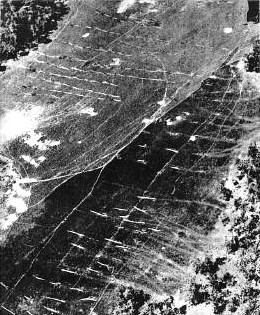
“PICCADILLY”
A NEAR TRAGEDY
(SEE NOTE ONE)
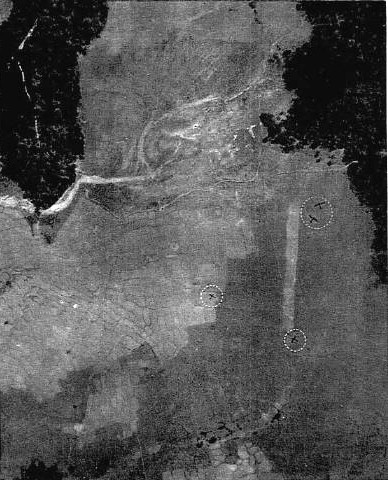
“BROADWAY”
Caved out of the jungle
behind enemy lines by airborne invasion.
(Note crashed gliders
from “Operation Thursday” circled)
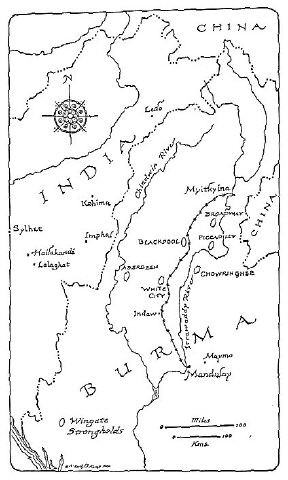
“OPERATION THURSDAY”
“CHINDITS” - SECOND
INCURSION
WINGATE IN BURMA
(SEE CREDIT ONE)
(AMENDED TO INCLUDE
SYLHET, ASSAM, INDIA)
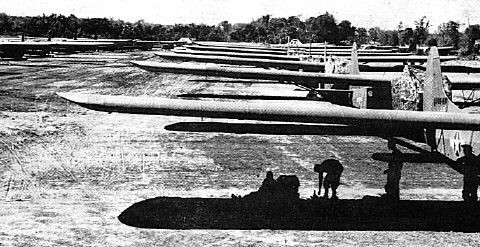
"Ready to Fly"
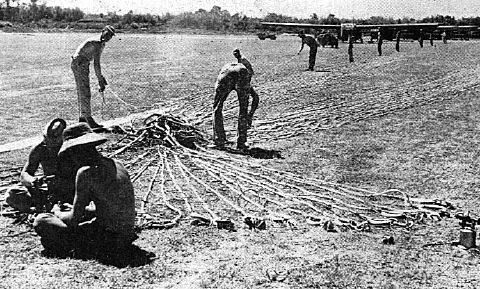
STRAIGHTENING THEIR
NYLONS
LINED UP AND READY
TO FLY
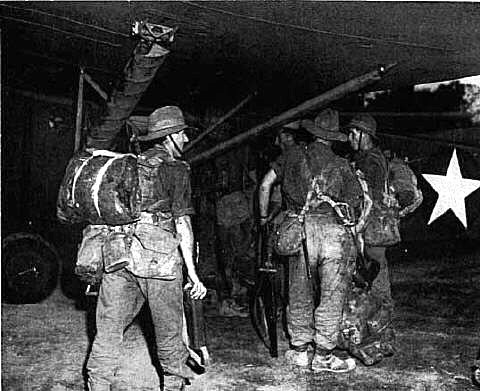
BOARDING A GLIDER
SOME NEVER TO RETURN
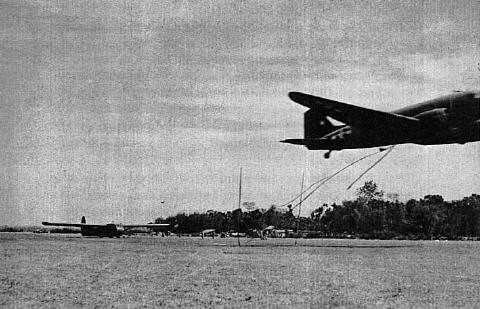
OFF INTO THE NIGHT
.jpg)
CHINDITS ARRIVE AT “BROADWAY” IN GLIDERS AND BEGIN PREPARING FIELD TO RECEIVE TRANSPORT AIRCRAFT WITHIN THIRTY-SIX HOURS
There being no transportation corps, Wingate employed over a thousand mules brought into the battle by air or air drop. The animal gave yeoman effort, with a huge heart, in the heat, rain and through the dense jungle over the rockiest of terrain.
In closing I write that Wingate proved you could beat the enemy at their
own game. He had established forever that long-range air supported
penetration operations behind enemy lines would prove successful, and that
it could be done with support from Camels, Elephants and Mules.
This conclusion
seems to be supported by the fact that the crash of the first two gliders
into “Chowringhee” was found to have been cause by two deep surface ruts
hidden in the tall grass. It was learned the ruts were caused by elephants
dragging teak logs into the clearing for drying. A procedure of long standing
with the natives of the area.
CREDIT TWO:
Time/Life
Harry A. Blair
Historian
Twenty-Seventh Troop
Carrier Squadron
La Crosse, Wisconsin
14 June 2001